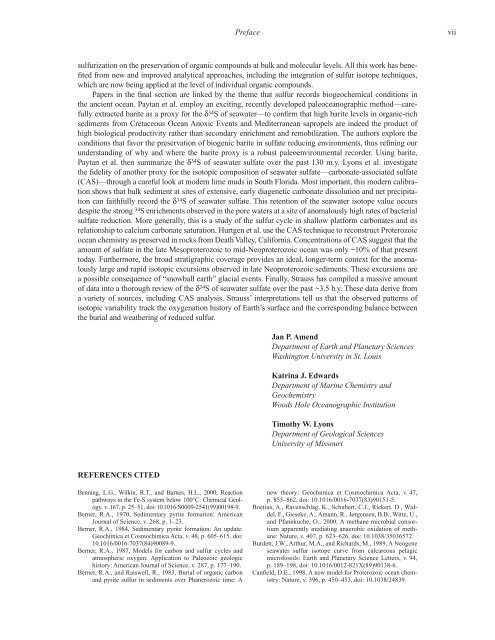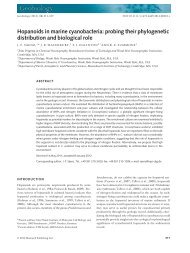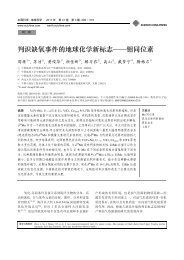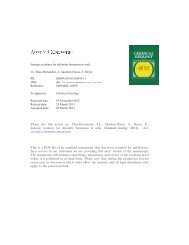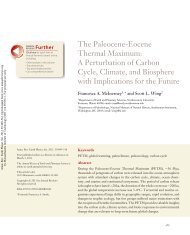Sulfur BiogeochemistryâPast and Present
Sulfur BiogeochemistryâPast and Present
Sulfur BiogeochemistryâPast and Present
- No tags were found...
Create successful ePaper yourself
Turn your PDF publications into a flip-book with our unique Google optimized e-Paper software.
Preface viisulfurization on the preservation of organic compounds at bulk <strong>and</strong> molecular levels. All this work has benefitedfrom new <strong>and</strong> improved analytical approaches, including the integration of sulfur isotope techniques,which are now being applied at the level of individual organic compounds.Papers in the final section are linked by the theme that sulfur records biogeochemical conditions inthe ancient ocean. Paytan et al. employ an exciting, recently developed paleoceanographic method—carefullyextracted barite as a proxy for the δ 34 S of seawater—to confirm that high barite levels in organic-richsediments from Cretaceous Ocean Anoxic Events <strong>and</strong> Mediterranean sapropels are indeed the product ofhigh biological productivity rather than secondary enrichment <strong>and</strong> remobilization. The authors explore theconditions that favor the preservation of biogenic barite in sulfate reducing environments, thus refining ourunderst<strong>and</strong>ing of why <strong>and</strong> where the barite proxy is a robust paleoenvironmental recorder. Using barite,Paytan et al. then summarize the δ 34 S of seawater sulfate over the past 130 m.y. Lyons et al. investigatethe fidelity of another proxy for the isotopic composition of seawater sulfate—carbonate-associated sulfate(CAS)—through a careful look at modern lime muds in South Florida. Most important, this modern calibrationshows that bulk sediment at sites of extensive, early diagenetic carbonate dissolution <strong>and</strong> net precipitationcan faithfully record the δ 34 S of seawater sulfate. This retention of the seawater isotope value occursdespite the strong 34 S enrichments observed in the pore waters at a site of anomalously high rates of bacterialsulfate reduction. More generally, this is a study of the sulfur cycle in shallow platform carbonates <strong>and</strong> itsrelationship to calcium carbonate saturation. Hurtgen et al. use the CAS technique to reconstruct Proterozoicocean chemistry as preserved in rocks from Death Valley, California. Concentrations of CAS suggest that theamount of sulfate in the late Mesoproterozoic to mid-Neoproterozoic ocean was only ~10% of that presenttoday. Furthermore, the broad stratigraphic coverage provides an ideal, longer-term context for the anomalouslylarge <strong>and</strong> rapid isotopic excursions observed in late Neoproterozoic sediments. These excursions area possible consequence of “snowball earth” glacial events. Finally, Strauss has compiled a massive amountof data into a thorough review of the δ 34 S of seawater sulfate over the past ~3.5 b.y. These data derive froma variety of sources, including CAS analysis. Strauss’ interpretations tell us that the observed patterns ofisotopic variability track the oxygenation history of Earth’s surface <strong>and</strong> the corresponding balance betweenthe burial <strong>and</strong> weathering of reduced sulfur.Jan P. AmendDepartment of Earth <strong>and</strong> Planetary SciencesWashington University in St. LouisKatrina J. EdwardsDepartment of Marine Chemistry <strong>and</strong>GeochemistryWoods Hole Oceanographic InstitutionTimothy W. LyonsDepartment of Geological SciencesUniversity of MissouriREFERENCES CITEDBenning, L.G., Wilkin, R.T., <strong>and</strong> Barnes, H.L., 2000, Reactionpathways in the Fe-S system below 100°C: Chemical Geology,v. 167, p. 25–51, doi: 10.1016/S0009-2541(99)00198-9.Berner, R.A., 1970, Sedimentary pyrite formation: AmericanJournal of Science, v. 268, p. 1–23.Berner, R.A., 1984, Sedimentary pyrite formation: An update:Geochimica et Cosmochimica Acta, v. 48, p. 605–615, doi:10.1016/0016-7037(84)90089-9.Berner, R.A., 1987, Models for carbon <strong>and</strong> sulfur cycles <strong>and</strong>atmospheric oxygen: Application to Paleozoic geologichistory: American Journal of Science, v. 287, p. 177–190.Berner, R.A., <strong>and</strong> Raiswell, R., 1983, Burial of organic carbon<strong>and</strong> pyrite sulfur in sediments over Phanerozoic time: Anew theory: Geochimica et Cosmochimica Acta, v. 47,p. 855–862, doi: 10.1016/0016-7037(83)90151-5.Boetius, A., Ravenschlag, K., Schubert, C.J., Rickert, D., Widdel,F., Gieseke, A., Amann, R., Jørgensen, B.B., Witte, U.,<strong>and</strong> Pfannkuche, O., 2000, A methane microbial consortiumapparently mediating anaerobic oxidation of methane:Nature, v. 407, p. 623–626, doi: 10.1038/35036572.Burdett, J.W., Arthur, M.A., <strong>and</strong> Richards, M., 1989, A Neogeneseawater sulfur isotope curve from calcareous pelagicmicrofossils: Earth <strong>and</strong> Planetary Science Letters, v. 94,p. 189–198, doi: 10.1016/0012-821X(89)90138-6.Canfield, D.E., 1998, A new model for Proterozoic ocean chemistry:Nature, v. 396, p. 450–453, doi: 10.1038/24839.


